Genetics
|
WikiDoc Resources for Genetics |
|
Articles |
|---|
|
Most recent articles on Genetics |
|
Media |
|
Evidence Based Medicine |
|
Clinical Trials |
|
Ongoing Trials on Genetics at Clinical Trials.gov Clinical Trials on Genetics at Google
|
|
Guidelines / Policies / Govt |
|
US National Guidelines Clearinghouse on Genetics
|
|
Books |
|
News |
|
Commentary |
|
Definitions |
|
Patient Resources / Community |
|
Directions to Hospitals Treating Genetics Risk calculators and risk factors for Genetics
|
|
Healthcare Provider Resources |
|
Causes & Risk Factors for Genetics |
|
Continuing Medical Education (CME) |
|
International |
|
|
|
Business |
|
Experimental / Informatics |
Editor-In-Chief: C. Michael Gibson, M.S., M.D. [1]
Associate Editor-In-Chief: Cafer Zorkun, M.D., Ph.D. [2]
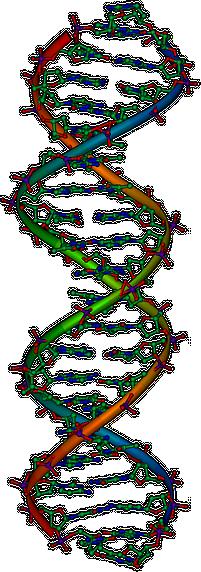
Genetics, a discipline of biology, is the science of heredity and variation in living organisms.[1][2] Knowledge of the inheritance of characteristics has been implicitly used since prehistoric times for improving crop plants and animals through selective breeding. However, the modern science of genetics, which seeks to understand the mechanisms of inheritance, only began with the work of Gregor Mendel in the mid-nineteenth century.[3] Although he did not know the physical basis for heredity, Mendel observed that inheritance is fundamentally a discrete process where specific traits are inherited in an independent manner—these basic units of inheritance are now called genes.
Genes correspond to regions within DNA, a molecule composed of a chain of four different types of nucleotides—the sequence of this nucleotides is the genetic information organisms inherit. DNA naturally occurs in a double stranded form, with nucleotides on each strand complementary to each other. Each strand can act as a template for synthesis of a new partner strand—this is the physical mechanism for the copying and inheritance of genetic information.
The sequence of nucleotides in DNA is used by cells to produce specific sequences of amino acids, creating proteins—a correspondence known as the genetic code. This sequence of amino acids in a protein determines how it folds into a three-dimensional structure, this structure is, in turn, responsible for the protein's function. Proteins carry out almost all the functions needed for cells to live and reproduce. A change to DNA sequence can change a protein's structure and behavior, and this can have dramatic consequences in the cell and on the organism as a whole.
Although genetics plays a large role in determining the appearance and behavior of organisms, it is the interaction of genetics with the environment an organism experiences that determines the ultimate outcome. For example, while genes play a role in determining a person's height, the nutrition and health that person experiences in childhood also have a large effect.
History
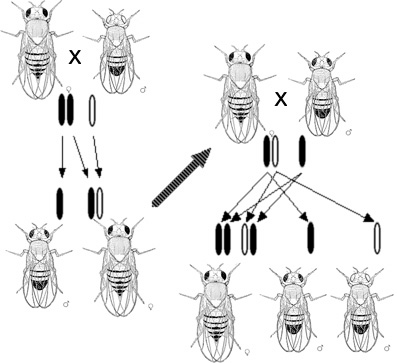
Although the science of genetics has its origins in the work of Gregor Mendel in the mid-nineteenth century, various theories of inheritance preceded Mendel. These theories generally assumed that there existed an inheritance of acquired characteristics: the belief that individuals inherit traits that have been strengthened in their parents. Today, the theory is commonly associated with Jean-Baptiste Lamarck, who used this pattern of inheritance to explain the evolution of various traits within species (these changes are now understood to be the product of natural selection rather than a product of soft inheritance).[4]
Mendelian and classical genetics
The modern science of genetics traces its roots to the observations made by Gregor Johann Mendel, a German-Czech Augustinian monk and scientist who made detailed studies of the nature of inheritance in plants. In his paper "Versuche über Pflanzenhybriden" ("Experiments on Plant Hybridization"), presented in 1865 to the Brunn Natural History Society, Gregor Mendel traced the inheritance patterns of certain traits in pea plants and showed that they could be described mathematically.[5] Although not all features show these patterns of Mendelian inheritance, his work suggested the utility of the application of statistics to the study of inheritance.
The significance of Mendel's observations was not understood until early in the twentieth century, after his death, when his research was re-discovered by other scientists working on similar problems. The word genetics itself was coined in 1905 by William Bateson, a significant proponent of Mendel's work, in a letter to Adam Sedgwick.[6][7] (The adjective genetic, derived from the Greek word genno (γεννώ): to give birth, predates the noun and was first used in a biological sense in 1860.[8]) Bateson publicly promoted and popularized usage of word genetics to describe the study of inheritance in his inaugural address to the Third International Conference on Plant Hybridization in London, England, in 1906.[9]
In the decades following rediscovery and popularization of Mendel's work, numerous experiments sought to elucidate the molecular basis of DNA. In 1910 Thomas Hunt Morgan argued that genes reside on chromosomes, based on observations of a sex-linked white eye mutation in fruit flies.[10] In 1913 his student Alfred Sturtevant used the phenomenon of genetic linkage and the associated recombination rates to demonstrate and map the linear arrangement of genes upon the chromosome.[11]

Molecular genetics
Although chromosomes were known to contain genes and composed of both protein and DNA, it was unknown which was critical for heredity or how the process occurred. In 1928, Frederick Griffith published his discovery of the phenomenon of transformation (see Griffith's experiment); sixteen years later, in 1944, Oswald Theodore Avery, Colin McLeod and Maclyn McCarty used this phenomenon to isolate and identify the molecule responsible for transformation as DNA.[12] The Hershey-Chase experiment in 1952 identified DNA (rather than protein) as the genetic material of the viruses that infect bacteria, further evidence that DNA was the molecule responsible for inheritance.[13]
James D. Watson and Francis Crick solved the structure of DNA in 1953, using the X-ray crystallography work of Rosalind Franklin that indicated the molecule had a helical structure.[14][15] Their double-helix model paired a sequence of nucleotides with complementary nucleotides on the other strand.[16] This structure not only provided a physical explanation for how information is contained within the order of the nucleotides, but also suggested a simple mechanism for duplication—through separation of strands and the reconstruction of partner strands based on the nucleotide sequences. Although the structure explained the process of inheritance, it was still unknown how DNA influenced the behavior of cells. In the following years scientists sought to understand how DNA controls the process of protein production within ribosomes, eventually discovering the transcription of DNA into messenger RNA and cracking the genetic code, which links the nucleotide sequence of messenger RNA to the amino acid sequence of protein.
With this molecular understanding of inheritance, an explosion of research that applied this new knowledge to biology became possible. One early development was chain-termination DNA sequencing in 1977, which enabled the determination of nucleotide sequences on DNA.[17] In 1983 the polymerase chain reaction, developed by Kary Banks Mullis, provided a simple method for isolating and amplifying segments of DNA.[18] These and other techniques, through the pooled efforts of the Human Genome Project and parallel private effort by Celera Genomics, culminated in the sequencing of the human genome in 2003.[19]
Features of inheritance
Discrete inheritance and Mendel's laws
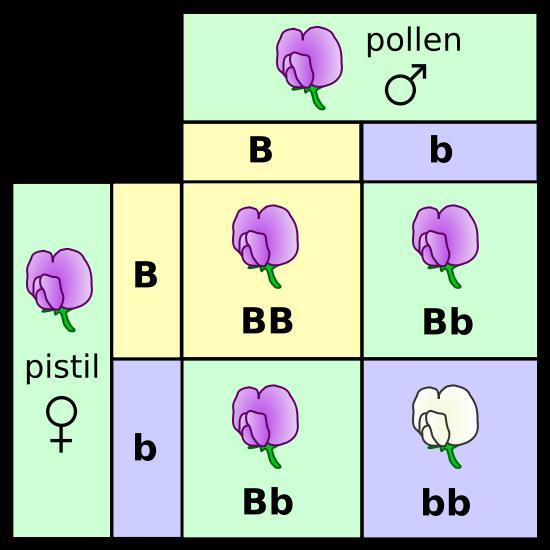
At its most fundamental level, inheritance in organisms occurs by means of discrete traits, called genes.[20] This property was first observed by Gregor Mendel, who studied the segregation of heritable traits in pea plants.[5][21] In his experiments studying the trait for flower color, Mendel observed that the flowers of each pea plant were either purple or white—and never an intermediate between the two colors. These different, discrete versions of the same gene are called alleles.
In the case of pea plants, each organism has two alleles of each gene, and the plants inherit one allele from each parent.[22] Many organisms, including humans, have this pattern of inheritance. Organisms with two copies of the same allele are called homozygous, while organisms with two different alleles are heterozygous.
The set of alleles for a given organism is called its genotype, while the observable trait the organism has is called its phenotype. When organisms are heterozygous, often one allele is called dominant as its qualities dominate the phenotype of the organism, while the other allele is called recessive as its qualities recede and are not observed. Some alleles do not have complete dominance and instead have incomplete dominance by expressing an intermediate phenotype, or codominance by expressing both alleles at once.[23]
When a pair of organisms reproduce sexually, their offspring randomly inherit one of the two alleles from each parent. These observations of discrete inheritance and the segregation of alleles are collectively known as Mendel's first law or the Law of Segregation.
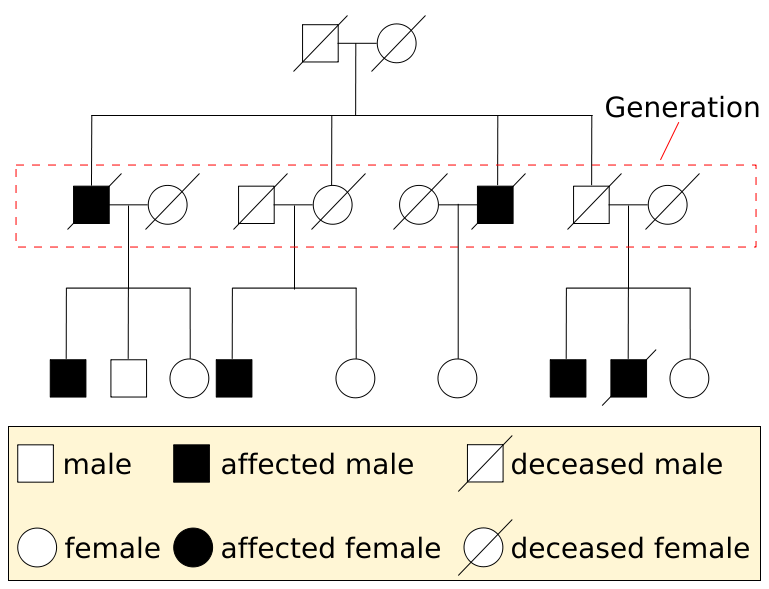
Notation and diagrams
Geneticists use diagrams and symbols to describe inheritance. A gene is represented by a letter (or letters)—the capitalized letter represents the dominant allele and the recessive is represented by lowercase.[24] Often a "+" symbol is used to mark the usual, non-mutant allele for a gene.
In fertilization and breeding experiments (and especially when discussing Mendel's) the parents are referred to as the "P" generation and the offspring as the "F1" (first filial) generation. When the F1 offspring mate with each other, the offspring are called the "F2" (second filial) generation. One of the common diagrams used to predict the result of cross-breeding is the Punnett square.
When studying human genetic diseases, geneticists often use pedigree charts to represent the inheritance of traits.[25] These charts map the inheritance of a trait in a family tree.
Interactions of multiple genes
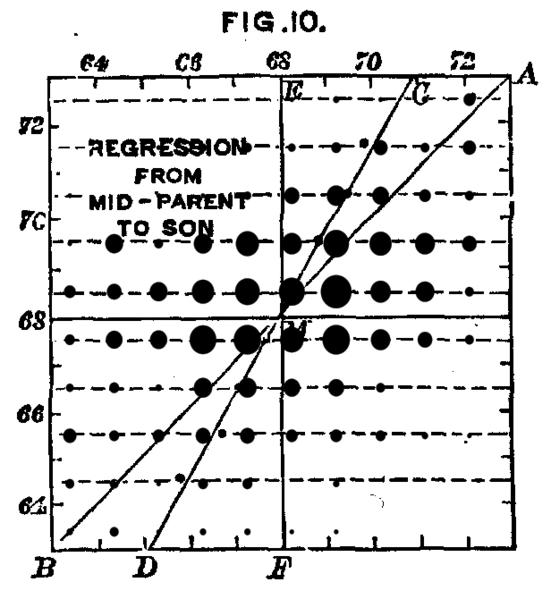
Organisms have thousands of genes, and in sexually reproducing organisms assortment of these genes are generally independent of each other. This means that the inheritance of an allele for yellow or green pea color is unrelated to the inheritance of alleles for white or purple flowers. This phenomenon, known as "Mendel's second law" or the "Law of independent assortment", means that the alleles of different genes get shuffled between parents to form offspring with many different combinations. (Some genes do not assort independently, demonstrating genetic linkage, a topic discussed later in this article.)
Often different genes can interact in a way that influences the same trait. In the blue-eyed Mary, for example, there exists a gene with alleles that determine the color of flowers: blue or magenta. Another gene, however, controls whether the flowers have color at all: color or white. When a plant has two copies of this white allele, its flowers are white—regardless of whether the first gene has blue or magenta alleles. This interaction between genes is called epistasis, with the second gene epistatic to the first.[26]
Many traits are not discrete features (eg. purple or white flowers) but are instead continuous features (eg. human height and skin color). These complex traits are the product of interactions of many genes.[27] The influence of these genes is mediated, to varying degrees, by the environment an organism has experienced. The degree to which an organism's genes contribute to a complex trait is called heritability.[28] Measurement of the heritability of a trait is relative, although—in a more variable environment, the environment has a bigger influence on the total variation of the trait. For example, human height is a complex trait with a heritability of 89% in the United States. In Nigeria, however, where people experience a more variable access to good nutrition and health care, height has a heritability of only 62%.[29]
Molecular basis for inheritance
DNA and chromosomes

The molecular basis for genes is deoxyribonucleic acid (DNA). DNA is composed of a chain of nucleotides, of which there are four types: adenine (A), cytosine (C), guanine (G), and thymine (T). Genetic information exists in the sequence of these nucleotides, and genes exist as stretches of sequence along the DNA chain.[30] Viruses are the only exception to this rule—sometimes viruses use the very similar molecule RNA instead of DNA as their genetic material.[31]
DNA normally exists as a double-stranded molecule, coiled into the shape of a double-helix. Each nucleotide in DNA preferentially pairs with its partner nucleotide on the opposite strand: A pairs with T, and C pairs with G. Thus, in its two-stranded form, each strand effectively contains all necessary information, redundant with its partner strand. This structure of DNA is the physical basis for inheritance: DNA replication duplicates the genetic information by splitting the strands and using each strand as a template for synthesis of a new partner strand.[32]
Genes are arranged linearly along long chains of DNA sequence, called chromosomes. In bacteria, each cell has a single circular chromosome, while eukaryotic organisms (which includes plants and animals) have their DNA arranged in multiple linear chromosomes. These DNA strands are often extremely long; the largest human chromosome, for example, is about 247 million base pairs in length.[33] The DNA of a chromosome is associated with structural proteins that organize, compact, and control access to the DNA, forming a material called chromatin; in eukaryotes chromatin is usually composed of nucleosomes, repeating units of DNA wound around a core of histone proteins.[34] The full set of hereditary material in an organism (usually the combined DNA sequences of all chromosomes) is called the genome.
While haploid organisms have only one copy of each chromosome, most animals and many plants are diploid, containing two of each chromosome and thus two copies of every gene.[35] The two alleles for a gene are located on identical loci of sister chromatids, each allele inherited from a different parent.

An exception exists in the sex chromosomes, specialized chromosomes many animals have evolved that play a role in determining the sex of an organism.[36] In humans and other mammals the Y chromosome has very few genes and triggers the development of male sexual characteristics, while the X chromosome is similar to the other chromosomes and contains many genes unrelated to sex determination. Females have two copies of the X chromosome, but males have one Y and only one X chromosome—this difference in X chromosome copy numbers leads to the unusual inheritance patterns of sex linked disorders.
Reproduction
When cells divide, their full genome is copied and each daughter cell inherits one copy. This is the simplest form of reproduction and is the basis for asexual reproduction. Asexual reproduction can also occur in multicellular organisms, producing offspring that inherit their genome from a single parent. Offspring that are genetically identical to their parents are called clones.
Eukaryotic organisms often use sexual reproduction to generate offspring that contain a mixture of genetic material inherited from two different parents. The process of sexual reproduction generally alternates between forms that contain single copies of the genome (haploid) and double copies (diploid).[35] Haploid cells fuse and combine genetic material to create a diploid cell with paired chromosomes. Diploid organisms form haploids by dividing, without replicating their DNA, to create daughter cells that randomly inherit one of each pair of chromosomes. Most animals and many plants are diploid for most of their lifespan, with the haploid form reduced to single cell gametes.
Although they do not use the haploid/diploid method of sexual reproduction, bacteria have many methods of acquiring new genetic information. Some bacteria can undergo conjugation, transferring a small circular piece of DNA to another bacterium.[37] Bacteria can also take up raw DNA fragments found in the environment and integrate them into their genome, a phenomenon known as transformation.[38] This processes result in horizontal gene transfer, transmitting fragments of genetic information between organisms that would otherwise be unrelated.
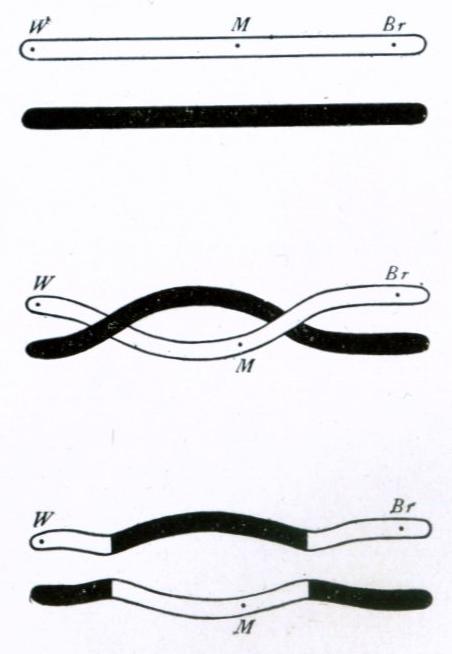
Recombination and linkage
The diploid nature of chromosomes allows for genes on different chromosomes to assort independently during sexual reproduction, recombining to form new combinations of genes. Genes on the same chromosome would theoretically never recombine, however, were it not for the process of chromosomal crossover. During crossover, chromosomes exchange stretches of DNA, effectively shuffling the gene alleles between the chromosomes.[39] This process of chromosomal crossover generally occurs during meiosis, a series of cell divisions that creates haploid germ cells that later combine with other germ cells to form child organisms.
The probability of chromosomal crossover occurring between two given points on the chromosome is related to the distance between them. For an arbitrarily long distance, the probability of crossover is high enough that the inheritance of the genes is effectively uncorrelated. For genes that are closer together, however, the lower probability of crossover means that the genes demonstrate genetic linkage—alleles for the two genes tend to be inherited together. The amounts of linkage between a series of genes can be combined to form a linear linkage map that roughly describes the arrangement of the genes along the chromosome.[40]
Gene expression

Genetic code
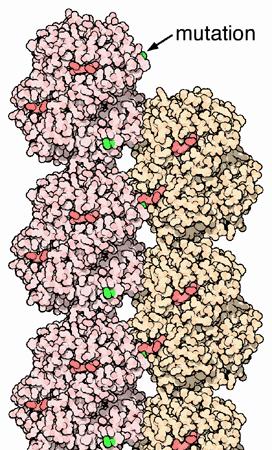
Genes generally express their functional effect through the production of proteins, which are complex molecules responsible for most functions in the cell.[41] Proteins are chains of amino acids, and the DNA sequence of a gene (through an RNA intermediate) is used to produce a specific protein sequence. Each group of three nucleotides in the sequence, called a codon, corresponds to one of the twenty possible amino acids in protein—this correspondence is called the genetic code.[42] The flow of information is unidirectional: information is transferred from nucleotide sequences into the amino acid sequence of proteins, but never from protein back into the sequence of DNA—a phenomenon Francis Crick called the central dogma of molecular biology.[43]
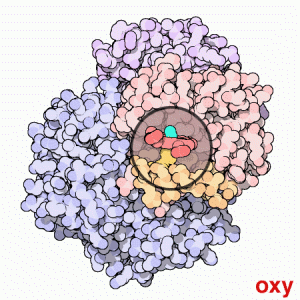
The specific sequence of amino acids results in a unique three-dimensional structure for that protein, and the three-dimensional structures of protein are related to their function.[44][45] Some are simple structural molecules, like the fibers formed by the protein collagen. Proteins can bind to other proteins and simple molecules, sometimes acting as enzymes by facilitating chemical reactions within the bound molecules (without changing the structure of the protein itself). Protein structure is dynamic; the protein hemoglobin bends into slightly different forms as it facilitates the capture, transport, and release of oxygen molecules within mammalian blood.
A single nucleotide difference within DNA can cause a single change in the amino acid sequence of a protein. Because protein structures are the result of their amino acid sequences, some changes can dramatically change the properties of a protein by destabilizing the structure or changing the surface of the protein in a way that changes its interaction with other proteins and molecules. For example, sickle-cell anemia is a human genetic disease that results from a single base difference within the coding region for the β-globin section of hemoglobin, causing a single amino acid change that changes hemoglobin's physical properties.[46] Sickle-cell versions of hemoglobin stick to themselves, stacking to form fibers that distort the shape of red blood cells carrying the protein. These sickle-shaped cells no longer flow smoothly through blood vessels, having a tendency to clot or degrade, causing the medical problems associated with the disease.
Nature vs. nurture
Although genes contain all the information an organism uses to function, the environment plays an important role in determining the ultimate phenotype—a dichotomy often referred to as "nature vs. nurture". The phenotype of an organism depends on the interaction of genetics with the environment. One example of this is the case of temperature-sensitive mutations. Often, a single amino acid change within the sequence of a protein does not change its behavior and interactions with other molecules, but it does destabilize the structure. In a high temperature environment, where molecules are moving more quickly and hitting each other, this results in the protein losing its structure and failing to function. In a low temperature environment, however, the protein's structure is stable and functions normally. This type of mutation is visible in the coat coloration of Siamese cats, where a mutation in an enzyme responsible for pigment production causes it to destabilize and lose function at high temperatures.[47] The protein remains functional in areas of skin that are colder—legs, ears, tail, and face—and so the cat has dark fur at its extremities.

Environment also plays a dramatic role in effects of the human genetic disease phenylketonuria.[48] The mutation that causes phenylketonuria disrupts the ability of the body to break down the amino acid phenylalanine, causing a toxic build-up of an intermediate molecule that, in turn, causes severe symptoms of progressive mental retardation and seizures. If someone with the phenylketonuria mutation is kept on a strict diet that avoids this amino acid, however, they remain normal and healthy.
Gene regulation
The genome of a given organism contains thousands of genes, but not all these genes need to be active at any given moment. A gene is expressed when it is being transcribed into mRNA (and translated into protein), and there exist many cellular methods of controlling the expression of genes such that proteins are produced only when needed by the cell. Transcription factors are regulatory proteins that bind to the start of genes, either promoting or inhibiting the transcription of the gene.[49] Within the genome of Escherichia coli bacteria, for example, there exists a series of genes necessary for the synthesis of the amino acid tryptophan. However, when tryptophan is already available to the cell, these genes for tryptophan synthesis are no longer needed. The presence of tryptophan directly affects the activity of the genes—tryptophan molecules bind to the tryptophan repressor (a transcription factor), changing the repressor's structure such that the repressor binds to the genes. The tryptophan repressor blocks the transcription and expression of the genes, thereby creating negative feedback regulation of the tryptophan synthesis process.[50]
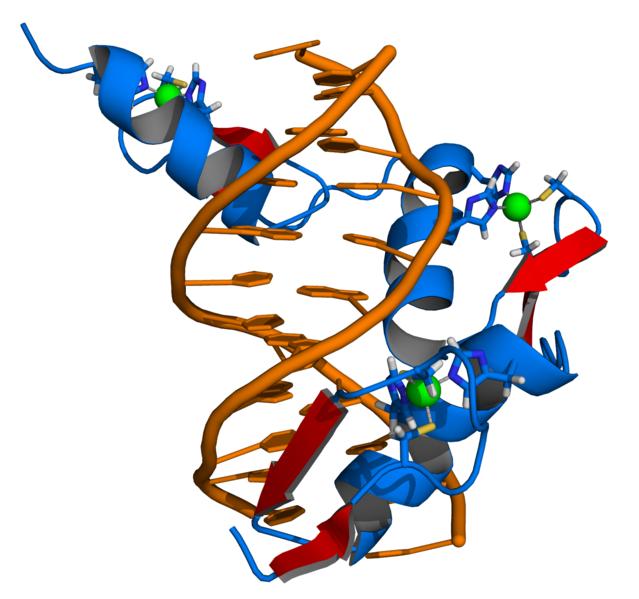
Differences in gene expression are especially clear within multicellular organisms, where cells all contain the same genome but have very different structures and behaviors due to the expression of different sets of genes. All the cells in a multicellular organism derive from a single cell, differentiating into different cell types in response to external and intercellular signals and gradually establishing different patterns of gene expression to create different behaviors. No single gene is responsible for the development of structures within multicellular organisms, these patterns arise from the complex interactions between many cells.
Within eukaryotes there exist structural features of chromatin that influence the transcription of genes, often in the form of modifications to DNA and chromatin that are stably inherited by daughter cells.[51] These features are called "epigenetic" because they exist "on top" of the DNA sequence and retain inheritance from one cell generation to the next. Because of epigenetic features, different cell types grown within the same medium can retain very different properties. Although epigenetic features are generally dynamic over the course of development, some, like the phenomenon of paramutation, have multigenerational inheritance and exist as rare exceptions to the general rule of DNA as the basis for inheritance.[52]
Genetic change
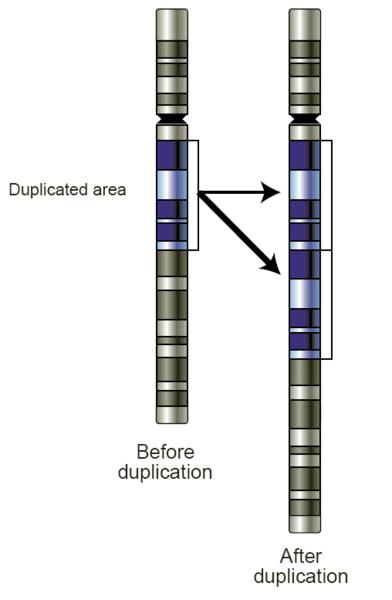
Mutations
During the process of DNA replication, errors occasionally occur in the polymerization of the second strand. These errors, called mutations, can have an impact on the phenotype of an organism, especially if they occur within the protein coding sequence of a gene. Error rates are usually very low—1 error in every 10–100 million bases—due to the "proofreading" ability of DNA polymerases.[53][54] (Without proofreading error rates are a thousand-fold higher; because many viruses rely on DNA and RNA polymerases that lack proofreading ability they experience higher mutation rates.) Processes that increase the rate of changes in DNA are called mutagenic: mutagenic chemicals promote errors in DNA replication, often by interfering with the structure of base-pairing, while UV radiation induces mutations by causing damage to the DNA structure.[55] Chemical damage to DNA occurs naturally as well, and cells use DNA repair mechanisms to repair mismatches and breaks in DNA—nevertheless, the repair sometimes fails to return the DNA to its original sequence.
In organisms that use chromosomal crossover to exchange DNA and recombine genes, errors in alignment during meiosis can also cause mutations.[56] Errors in crossover are especially likely when similar sequences cause partner chromosomes to adopt a mistaken alignment; this makes some regions in genomes more prone to mutating in this way. These errors create large structural changes in DNA sequence—duplications, inversions or deletions of entire regions, or the accidental exchanging of whole parts between different chromosomes (called translocation).
Natural selection and evolution
Mutations produce organisms with different genotypes, and those differences can result in different phenotypes. Many genetic mutations have a negligible effect on an organism's phenotype, health, and reproductive fitness. Mutations that do have an effect are often deleterious, but occasionally mutations arise that are beneficial in the current environmental context of the organism.
File:Eukaryote tree.svg Population genetics research studies the distributions of these genetic differences within populations and how the distributions change over time.[57] Changes in the frequency of an allele in a population can be influenced by natural selection, where a given allele's higher rate of survival and reproduction causes it to become more frequent in the population over time.[58] Genetic drift can also occur, where chance events lead to random changes in allele frequency.[59]
Over many generations, the genomes of organisms can change, resulting in the phenomenon of evolution. Mutations and the selection for beneficial mutations can cause a species to evolve into forms that better survive their environment, a process called adaptation.[60] New species are formed through the process of speciation, a process often caused by geographical separations that allow different populations to genetically diverge.[61]
As sequences diverge and change during the process of evolution, these differences between sequences can be used as a molecular clock to calculate the evolutionary distance between them.[62] Genetic comparisons are generally considered the most accurate method of characterizing the relatedness between species, an improvement over the sometimes deceptive comparison of phenotypic characteristics. The evolutionary distances between species can be combined to form evolutionary trees—these trees represent the common descent and divergence of species over time, although they cannot represent the transfer of genetic material between unrelated species (known as horizontal gene transfer and most common in bacteria).
Research and technology
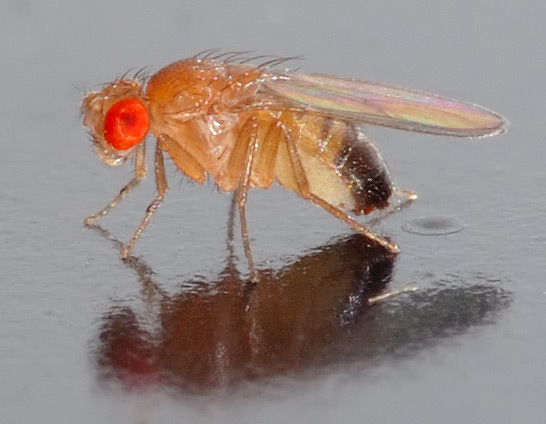
Model organisms and genetics
Although geneticists originally studied inheritance in a wide range of organisms, researchers began to specialize in studying the genetics of a particular subset of organisms. The fact that significant research already existed for a given organism would encourage new researchers to choose it for further study, and so eventually a few model organisms became the basis for most genetics research.[63] Common research topics in model organism genetics include the study of gene regulation and the involvement of genes in development and cancer.
Organisms were chosen, in part, for convenience—short generation times and facile genetic manipulation made some organisms popular genetics research tools. Widely used model organisms include the gut bacterium Escherichia coli, the plant Arabidopsis thaliana, baker's yeast (Saccharomyces cerevisiae), the nematode Caenorhabditis elegans, the common fruit fly (Drosophila melanogaster), and the common house mouse (Mus musculus).
Medical genetics research
Medical genetics seeks to understand how genetic variation relates to human health and disease.[64] When searching for an unknown gene that may be involved in a disease, researchers commonly use genetic linkage and genetic pedigree charts to find the location on the genome associated with the disease. At the population level, researchers take advantage of Mendelian randomization to look for locations in the genome that are associated with diseases, a technique especially useful for multigenic traits not clearly defined by a single gene.[65] Once a candidate gene is found, further research is often done on the same gene (called an orthologous gene) in model organisms. In addition to studying genetic diseases, the increased availability of genotyping techniques has led to the field of pharmacogenetics—studying how genotype can affect drug responses.[66]
Although it is not an inherited disease, cancer is also considered a genetic disease.[67] The process of cancer development in the body is a combination of events. Mutations occasionally occur within cells in the body as they divide—while these mutations will not be inherited by any offspring, they can affect the behavior of cells, sometimes causing them to grow and divide more frequently. There are biological mechanisms that attempt to stop this process—signals are given to inappropriately dividing cells that should trigger cell death, but sometimes additional mutations occur that cause cells to ignore these messages. An internal process of natural selection occurs within the body and eventually mutations accumulate within cells to promote their own growth, creating a cancerous tumor that grows and invades various tissues of the body.
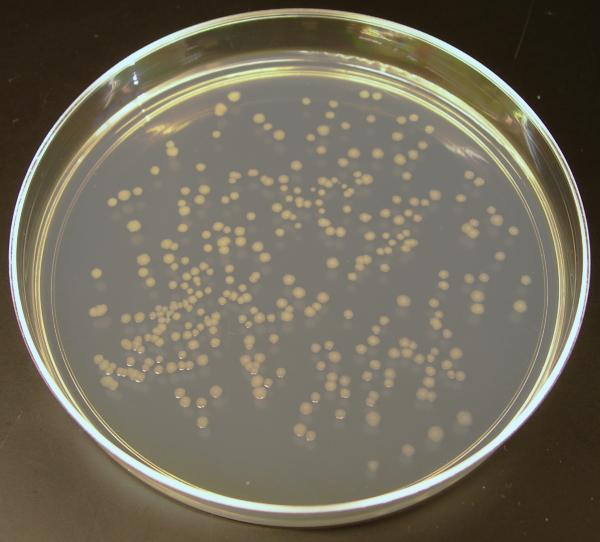
In an effort to speed up the progress of medical research, ten individuals made their genetic information, medical histories, ethnic backgrounds, and other phenotypes publicly available on October 21, 2008. The ten individuals, all of whom have at least the equivalent of masters degree in genetics, are the first set of participants in the Harvard based Personal Genome Project]. Project leader George Church hopes to change the public perception that individuals should keep their genetic information private by exploring the consequences of making genetic and medical information publicly accessible. Officials from the project hope to eventually enroll up to 100,000 participants.[68]
Research techniques
DNA can be manipulated in the laboratory. Restriction enzymes are a commonly used enzyme that cuts DNA at specific sequences, producing predictable fragments of DNA.[69] The use of ligation enzymes allows these fragments to be reconnected, and by ligating fragments of DNA together from different sources, researchers can create recombinant DNA. Often associated with genetically modified organisms, recombinant DNA is commonly used in the context of plasmids—short circular DNA fragments with a few genes on them. By inserting plasmids into bacteria and growing those bacteria on plates of agar (to isolate clones of bacteria cells), researchers can clonally amplify the inserted fragment of DNA (a process known as molecular cloning). (Cloning can also refer to the creation of clonal organisms, through various techniques.)
DNA can also be amplified using a procedure called the polymerase chain reaction (PCR).[70] By using specific short sequences of DNA, PCR can isolate and exponentially amplify a targeted region of DNA. Because it can amplify from extremely small amounts of DNA, PCR is also often used to detect the presence of specific DNA sequences.
DNA sequencing and genomics
One of the most fundamental technologies developed to study genetics, DNA sequencing allows researchers to determine the sequence of nucleotides in DNA fragments. Developed in 1977 by Frederick Sanger and coworkers, chain-termination sequencing is now routinely used to sequence DNA fragments.[71] With this technology, researchers have been able to study the molecular sequences associated with many human diseases. As sequencing has become less expensive and with the aid of computational tools, researchers have sequenced the genomes of many organisms by stitching together the sequences of many different fragments (a process called genome assembly).[72] These technologies were used to sequence the human genome, leading to the completion of the Human Genome Project in 2003.[19]
The large amount of sequences available has created the field of genomics, research that uses computational tools to search for and analyze patterns in the full genomes of organisms. Genomics can also be considered a subfield of bioinformatics, which uses computational approaches to analyze large sets of biological data.
References
- Alberts B, Johnson A, Lewis J, Raff M, Roberts K, and Walter P (2002). Molecular Biology of the Cell (4th edition ed.). ISBN 0-8153-3218-1.
- Griffiths AJF, Miller JH, Suzuki DT, Lewontin RC, and Gelbart WM (2000). An Introduction to Genetic Analysis. New York: W.H. Freeman and Company. ISBN 0-7167-3520-2.
- Hartl D, Jones E (2005). Genetics: Analysis of Genes and Genomes, 6th edition. Jones & Bartlett. ISBN 0-7637-1511-5.
- Lodish H, Berk A, Zipursky LS, Matsudaira P, Baltimore D, and Darnell J (2000). Molecular Cell Biology (4th edition ed.). ISBN 0-7167-3136-3.
Notes
- ↑ Griffiths et al. (2000)
- ↑ Hartl D, Jones E (2005)
- ↑ Weiling F (1991). "Historical study: Johann Gregor Mendel 1822–1884". American Journal of Medical Genetics. 40 (1): 1–25, discussion 26. PMID 1887835.
- ↑ Lamarck, J-B (2008). In Encyclopædia Britannica. Retrieved from Encyclopædia Britannica Online on 2008-03-16.
- ↑ 5.0 5.1 Mendel, GJ (1866). "Versuche über Pflanzen-Hybriden". Verhandlungen des naturforschenden Vereins Brünn. 4: 3–47. (in English in 1901, J. R. Hortic. Soc. 26: 1–32) translation available online
- ↑ genetics, n., Oxford English Dictionary, 3rd ed.
- ↑ Bateson W. "Letter from William Bateson to Alan Sedgwick in 1905". The John Innes Centre. Retrieved 2008-03-15.
- ↑ genetic, adj., Oxford English Dictionary, 3rd ed.
- ↑ Bateson, W (1907). "The Progress of Genetic Research". In Wilks, W (editor). Report of the Third 1906 International Conference on Genetics: Hybridization (the cross-breeding of genera or species), the cross-breeding of varieties, and general plant breeding. London: Royal Horticultural Society.
- Although the conference was titled "International Conference on Hybridisation and Plant Breeding", Wilks changed the title for publication as a result of Bateson's speech.
- ↑ Moore JA (1983). "Thomas Hunt Morgan—The Geneticist". American Zoologist. 23 (4): 855–865.
- ↑ Sturtevant AH (1913). "The linear arrangement of six sex-linked factors in Drosophila, as shown by their mode of association". Journal of Experimental Biology. 14: 43–59. pdf from Electronic Scholarly Publishing
- ↑ Avery OT, MacLeod CM, and McCarty M (1944). "Studies on the Chemical Nature of the Substance Inducing Transformation of Pneumococcal Types: Induction of Transformation by a Desoxyribonucleic Acid Fraction Isolated from Pneumococcus Type III". Journal of Experimental Medicine. 79 (1): 137–158.35th anniversary reprint available
- ↑ Hershey AD, Chase M (1952). "Independent functions of viral protein and nucleic acid in growth of bacteriophage". The Journal of General Physiology. 36: 39–56.
- ↑ Judson, Horace (1979). The Eighth Day of Creation: Makers of the Revolution in Biology. Cold Spring Harbor Laboratory Press. pp. 51–169. ISBN 0-87969-477-7. Unknown parameter
|middle=ignored (help) - ↑ Watson JD, Crick FHC (1953). "[[Molecular structure of Nucleic Acids]]: A Structure for Deoxyribose Nucleic Acid" (PDF). Nature. 171 (4356): 737–738. URL–wikilink conflict (help)
- ↑ Watson JD, Crick FHC (1953). "Genetical Implications of the Structure of Deoxyribonucleic Acid" (PDF). Nature. 171 (4361): 964–967.
- ↑ Sanger F, Nicklen S, and Coulson AR (1977). "DNA sequencing with chain-terminating inhibitors". Nature. 74 (12): 5463–5467.
- ↑ Saiki RK, Scharf S, Faloona F, Mullis KB, Horn GT, Erlich HA, Arnheim N (1985). "Enzymatic Amplification of β-Globin Genomic Sequences and Restriction Site Analysis for Diagnosis of Sickle Cell Anemia". Science. 230 (4732): 1350–1354. PMID 2999980.
- ↑ 19.0 19.1 "Human Genome Project Information". Human Genome Project. Retrieved 2008-03-15.
- ↑ Griffiths et al. (2000), Chapter 2 (Patterns of Inheritance): Introduction
- ↑ Griffiths et al. (2000), Chapter 2 (Patterns of Inheritance): Mendel's experiments
- ↑ Griffiths et al. (2000), Chapter 3 (Chromosomal Basis of Heredity): Mendelian genetics in eukaryotic life cycles
- ↑ Griffiths et al. (2000), Chapter 4 (Gene Interaction): Interactions between the alleles of one gene
- ↑ Richard W. Cheney. "Genetic Notation". Retrieved 2008-03-18.
- ↑ Griffiths et al. (2000), Chapter 2 (Patterns of Inheritance): Human Genetics
- ↑ Griffiths et al. (2000), Chapter 4 (Gene Interaction): Gene interaction and modified dihybrid ratios
- ↑ Mayeux R (2005). "Mapping the new frontier: complex genetic disorders". The Journal of Clinical Investigation. 115 (6): 1404–1407. PMID 15931374.
- ↑ Griffiths et al. (2000), Chapter 25 (Quantitative Genetics): Quantifying heritability
- ↑ Luke A, Guo X, Adeyemo AA, Wilks R, Forrester T, Lowe W Jr, Comuzzie AG, Martin LJ, Zhu X, Rotimi CN, Cooper RS (2001). "Heritability of obesity-related traits among Nigerians, Jamaicans and US black people". Int J Obes Relat Metab Disord. 25 (7): 1034–1041. Abstract from NCBI
- ↑ Pearson H (2006). "Genetics: what is a gene?". Nature. 441 (7092): 398–401. PMID 16724031.
- ↑ Prescott, L (1993). Microbiology. Wm. C. Brown Publishers. 0-697-01372-3.
- ↑ Griffiths et al. (2000), Chapter 8 (The Structure and Replication of DNA): Mechanism of DNA Replication
- ↑ Gregory SG; et al. (2006). "The DNA sequence and biological annotation of human chromosome 1". Nature. 441: 315–321. free full text available
- ↑ Alberts et al. (2002), DNA and chromosomes: Chromosomal DNA and Its Packaging in the Chromatin Fiber
- ↑ 35.0 35.1 Griffiths et al. (2000), Chapter 3 (Chromosomal Basis of Heredity): Mendelian genetics in eukaryotic life cycles
- ↑ Griffiths et al. (2000), Chapter 2 (Patterns of Inheritance): Sex chromosomes and sex-linked inheritance
- ↑ Griffiths et al. (2000), Chapter 7 (Gene Transfer in Bacteria and Their Viruses): Bacterial conjugation
- ↑ Griffiths et al. (2000), Chapter 7 (Gene Transfer in Bacteria and Their Viruses): Bacterial transformation
- ↑ Griffiths et al. (2000), Chapter 5 (Basic Eukaryotic Chromosome Mapping): Nature of crossing-over
- ↑ Griffiths et al. (2000), Chapter 5 (Basic Eukaryotic Chromosome Mapping): Linkage maps
- ↑ Some genes are transcribed into RNA, but their RNA products are never used to produce protein. These RNA products may fold into forms with enzymatic properties (eg. ribosomal RNA and transfer RNA), or they may have a regulatory effect through hybridization interactions with other RNA molecules (eg. microRNA).
- ↑ Berg JM, Tymoczko JL, Stryer L, Clarke ND (2002). Biochemistry (5th edition ed.). New York: W. H. Freeman and Company. I. 5. DNA, RNA, and the Flow of Genetic Information: Amino Acids Are Encoded by Groups of Three Bases Starting from a Fixed Point
- ↑ Crick, F (1970): Central Dogma of Molecular Biology (PDF). Nature 227, 561–563. PMID 4913914
- ↑ Alberts et al. (2002), Proteins: The Shape and Structure of Proteins
- ↑ Alberts et al. (2002), Proteins: Protein Function
- ↑ "How Does Sickle Cell Cause Disease?". Brigham and Women's Hospital: Information Center for Sickle Cell and Thalassemic Disorders. 2002-04-11. Retrieved 2007-07-23.
- ↑ Imes DL, Geary LA, Grahn RA, Lyons LA (2006). "Albinism in the domestic cat (Felis catus) is associated with a tyrosinase (TYR) mutation" (Short Communication). Animal Genetics. 37 (2): 175. Retrieved 2006-05-29.
- ↑ "MedlinePlus: Phenylketonuria". NIH: National Library of Medicine. Retrieved 2008-03-15.
- ↑ Brivanlou AH, Darnell JE Jr (2002). "Signal transduction and the control of gene expression". Science. 295 (5556): 813–818. PMID 11823631.
- ↑ Alberts et al. (2002), Control of Gene Expression - The Tryptophan Repressor Is a Simple Switch That Turns Genes On and Off in Bacteria
- ↑ Jaenisch R, Bird A. "Epigenetic regulation of gene expression: how the genome integrates intrinsic and environmental signals". Nature Genetics. 33 (3s): 245–254.
- ↑ Chandler VL (2007). "Paramutation: From Maize to Mice". Cell. 128: 641–645.
- ↑ Griffiths et al. (2000), Chapter 16 (Mechanisms of Gene Mutation): Spontaneous mutations
- ↑ Kunkel TA (2004). "DNA Replication Fidelity". Journal of Biological Chemistry. 279 (17): 16895–16898.
- ↑ Griffiths et al. (2000), Chapter 16 (Mechanisms of Gene Mutation): Induced mutations
- ↑ Griffiths et al. (2000), Chapter 17 (Chromosome Mutation I: Changes in Chromosome Structure): Introduction
- ↑ Griffiths et al. (2000), Chapter 24 (Population Genetics): Variation and its modulation
- ↑ Griffiths et al. (2000), Chapter 24 (Population Genetics): Selection
- ↑ Griffiths et al. (2000), Chapter 24 (Population Genetics): Random events
- ↑ Darwin, Charles (1859). On the Origin of Species (1st ed.). London: John Murray. p. 1.. Related earlier ideas were acknowledged in Darwin, Charles (1861). On the Origin of Species (3rd ed.). London: John Murray. pp. xiii.
- ↑ Gavrilets S (2003). "Perspective: models of speciation: what have we learned in 40 years?". Evolution. 57 (10): 2197–2215. PMID 14628909.
- ↑ Wolf YI, Rogozin IB, Grishin NV, Koonin EV (2002). "Genome trees and the tree of life". Trends Genet. 18 (9): 472&ndash, 479. PMID 12175808.
- ↑ "The Use of Model Organisms in Instruction". University of Wisconsin: Wisconsin Outreach Research Modules. Retrieved 2008-03-15.
- ↑ "NCBI: Genes and Disease". NIH: National Center for Biotechnology Information. Retrieved 2008-03-15.
- ↑ Smith GD, Ebrahim S (2003). "'Mendelian randomization': can genetic epidemiology contribute to understanding environmental determinants of disease?". International Journal of Epidemiology. 32: 1–22.
- ↑ "Pharmacogenetics Fact Sheet". NIH: National Institute of General Medical Sciences. Retrieved 2008-03-15.
- ↑ Strachan T, Read AP (1999). Human Molecular Genetics 2 (second edition ed.). John Wiley & Sons Inc.Chapter 18: Cancer Genetics
- ↑ http://rs6.net/tn.jsp?t=cpxyzscab.0.0.g7akgrbab.0&p=http%3A%2F%2Fwww.nytimes.com%2F2008%2F10%2F20%2Fus%2F20gene.html%3Fpagewanted%3D1%26_r%3D2%26hp&id=preview
- ↑ Lodish et al. (2000), Chapter 7: 7.1. DNA Cloning with Plasmid Vectors
- ↑ Lodish et al. (2000), Chapter 7: 7.7. Polymerase Chain Reaction: An Alternative to Cloning
- ↑ Brown TA (2002). Genomes 2 (2nd edition ed.). ISBN ISBN 1 85996 228 9 Check
|isbn=value: invalid character (help).Section 2, Chapter 6: 6.1. The Methodology for DNA Sequencing - ↑ Brown (2002), Section 2, Chapter 6: 6.2. Assembly of a Contiguous DNA Sequence
External links
|
Cleft lip and palate Microchapters |
|
Diagnosis |
|---|
|
Treatment |
|
Case Studies |
|
Genetics On the Web |
|
American Roentgen Ray Society Images of Genetics |
af:Genetika
ar:علم الوراثة
ast:Xenética
az:Genetika
bg:Генетика
bn:জিনতত্ত্ব
bs:Genetika
ca:Genètica
cs:Genetika
da:Genetik
de:Genetik
diq:Cênetik
el:Γενετική
eo:Genetiko
et:Geneetika
fi:Perinnöllisyystiede
ga:Géineolaíocht
gd:Gintinneachd
gl:Xenética
he:גנטיקה
hr:Genetika
hu:Genetika
id:Genetika
io:Genetiko
is:Erfðafræði
it:Genetica
jbo:ginske
ka:გენეტიკა
ko:유전학
ku:Genetîk
la:Genetica
lb:Genetik
lt:Genetika
lv:Ģenētika
mk:Генетика
mn:Генетик
ms:Genetik
nl:Genetica
no:Genteknologi
nov:Genetike
oc:Genetica
os:Генетикæ
qu:Hinitika
sh:Genetika
simple:Genetics
sk:Genetika
sl:Genetika
sq:Gjenetika
sr:Генетика
su:Genetika
sv:Genetik
ta:மரபியல்
tg:Генетика
th:พันธุศาสตร์
tl:Henetika
uk:Генетика
ur:وراثیات
uz:Genetika